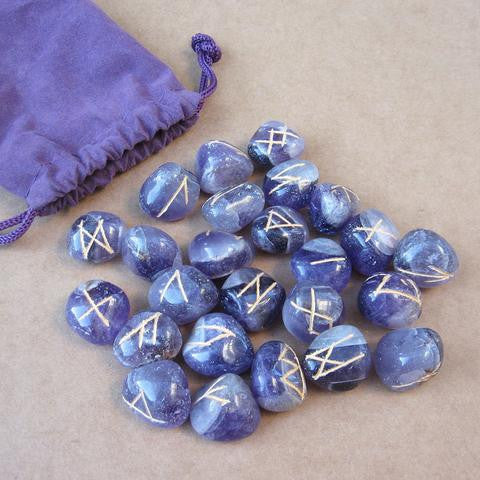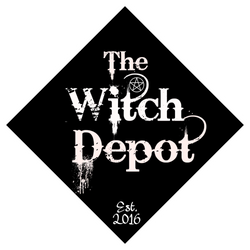
Amethyst Runes
Regular price
$25.00
Sale
Rune History
No-one knows exactly how old the runes are. Rune-like symbols appear as cave markings as early as the late Bronze Age (circa 1300 BC), and they are mentioned in the Bible, but their use in ritual and as an Oracle for consultation must certainly pre-date their use as a system of writing.
Eminent scientific runologist Dr R. I. Page of Cambridge University (An Introduction to English Runes 1973,1999 and Reading the Past - Runes 1987) notes that the runic forms were well established and gave the appearance of having been in use for some centuries before the time of the earliest written language inscriptions.
The fact that the runes were each given meaningful names confirms that they had some magical or religious significance to their users long before they emerged as an alphabet for records and messages.
The word rune itself comes from the old Norse word Runa meaning a secret or mystery, and it seems likely that the early runemasters and Rune mistresses were considered to have some magic or mystic power in their understanding of the runes.
The runes represent objects, gods, people, animals, concepts and occurrences. They were known by names from which their alphabetic and phonetic values were taken, but it must be remembered that the early Germanic and Norse tribes who developed them did so long before they had any need for writing messages.
It was not until about AD200, when the runemal (i.e. the art of runic interpretation) was wide-spread in Northern Europe that the runic alphabet emerged. This alphabet became known as the Futhark or Futhorc, after the names of the first 6 runes (Fehu, Uruz, Thurisaz, Ansuz, Raido, Kauno) and it is these 24 symbols that now comprise the rune set. Some modern diviners also use a blank to represent Odin, fate or destiny - but it is probably more useful as a spare in case of loss. A blank cannot rightfully be called a "rune" because there is no symbol on it. And in any case, the rune Ansuz is generally accepted to represent Odin by the majority of experienced rune users.
There are very few surviving runic inscriptions and most of them are on stone or metal - the most durable of materials. Only a handful of inscriptions carved on wood have ever been found, and none of these is from Britain.
There is sufficient evidence to show that the Ancient Pagan or Anglo-Saxon runes (known to runologists as the Anglo-Friesian runes from their geographical occurrence) are the same 24 basic runes with variations in their form due to usage over the centuries.
For example, the Hagalaz of the Norse resembled an angled H but the Anglo-Saxons added a second cross-bar.
Variations in pronunciation can also occur. For instance, the Norsemen pronounced W as a V, but Anglo-Saxons had adapted this to the modern W sound by 600AD.
There are those who suggest that many of the rune forms are copied from Roman script - the system of letters on which modern Western writing is based.
Such examples as Mannaz (M), Fehu (F), Berkanan (B), Raido (R) are obviously very similar, but it seems more likely to me that the rune symbols (although not then used as letters) are earlier in development. Or at least, they were developed from the same source as the Roman script.
Consider the technology and equipment that was necessary to undertake Roman writing. Parchment or paper with all the processing that requires - such as blanching chemicals and drying processes; the formulation of durable ink and its mass production; and not forgetting the development of a complex writing implement such as the quill pen. A civilization is hardly likely to undertake all these developments unless a suitable format for writing already existed.
Look now at the needs of the rune master or rune mistress, what did they require? Nothing more than a stick of wood and a sharp knife to incise the runes. Both of these requisites have been available to Man from the very earliest times. That runes were initially cut in wood there is no doubt. The very shape of the runes confirms this by the avoidance of the horizontal or curved line.
If you experiment with a flat wood surface, you will find that it is very easy to cut straight lines across the grain. It is much more difficult to cut a curve with a straight knife blade. And it is almost impossible to cut a line horizontally along the grain - the cut closes up as the wood dries, and the line thus disappears.
The early runemasters and rune mistresses therefore developed a system of writing from their existing fund of mystic or religious symbols which would endure on wood. The symbols were composed of vertical and angled straight lines that could easily be cut or burned in wood.
The later Roman historian Cornelius Tacitus (58-120AD) records a Germanic tribal Runemal in some detail in Chapter 10 of his ethnographical work Germania from about 97AD when he was Consul to the region:
To divination they pay much attention. Their method is a simple one: they cut a branch from a fruit-bearing tree and divide it into small pieces which they mark with certain distinctive signs and scatter at random onto a white cloth. Then the priest of the community (if it is done publicly) or the father of the family (if it is done privately) after invoking the gods and with eyes raised to heaven, picks up three pieces one at a time and interprets them in accordance with the signs previously marked on them.
When the high chieftains and lawgivers of Anglo-Saxon England met in secret, their assemblies were known as The Runes: and a 4th Century translation of the Bible uses the word Runa for "mystery" or "secret proceedings".
The ancient Norse prose tales of the Edda have Odin hung on the World Tree when he spies the runes and seizes them up to gain wisdom and well-being. The Edda also mentions Bragi, master of the skalds (minstrels) and a great storyteller who reputedly had runes tattooed on his tongue - a reference to his magical gift as a raconteur.
The slightly later poem Erik the Red describes a Rune mistress in full regalia.
Coming to modern references, the traditional lore of Finland as recorded in the Kalevala by Lönnrot in 1835 describes a confrontation of wizards where runic songs were used to cause fire and devastation.
Some modern experts allege that stones were commonly used for the Runemal, but I have found no evidence of this despite extensive research. The indications, whether from runology, known Pagan religious beliefs, or Saxon witchcraft ritual, all point to the use of wood, particularly from fruit-bearing trees.
In my efforts to accurately recreate the Ancient Runemal, my rune sets were made from Blackthorn, Ash, Beech, Birch, Chestnut, Elder, Hawthorn, Hazel, Rowan, Sycamore, Willow and a few other wild woods. In keeping with the Pagan respect for living things, I never cut from living trees, but used windfall or forested branches. Each rune set was individually dated, serial numbered and identified as to the wood and its origin.
Information from: http://www.runemaker.com/history.shtml
